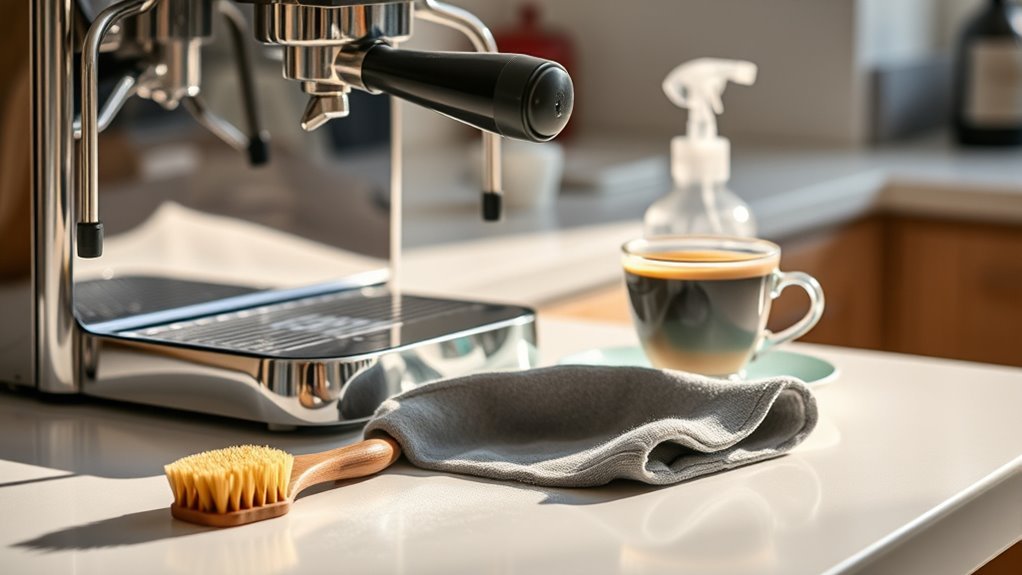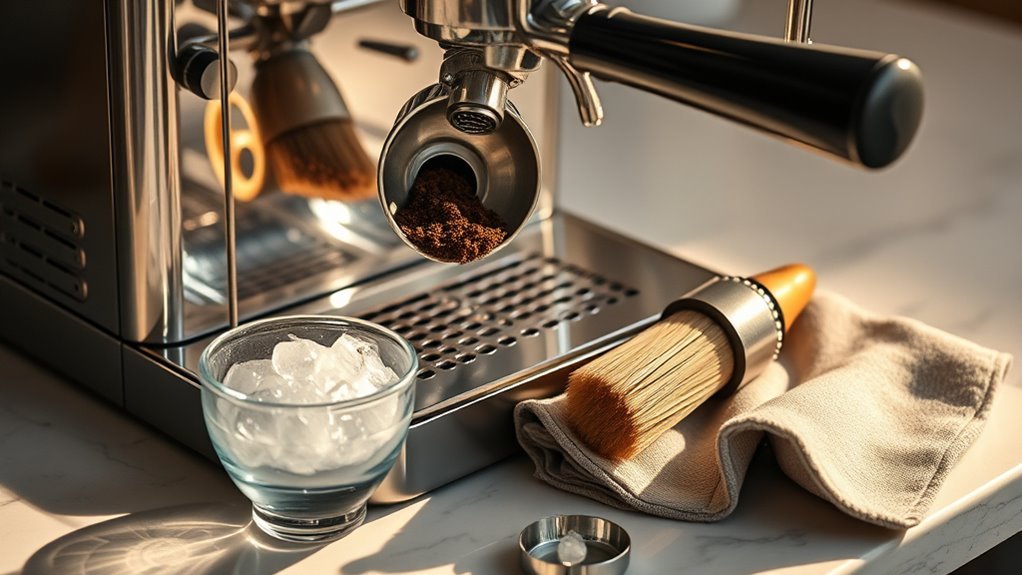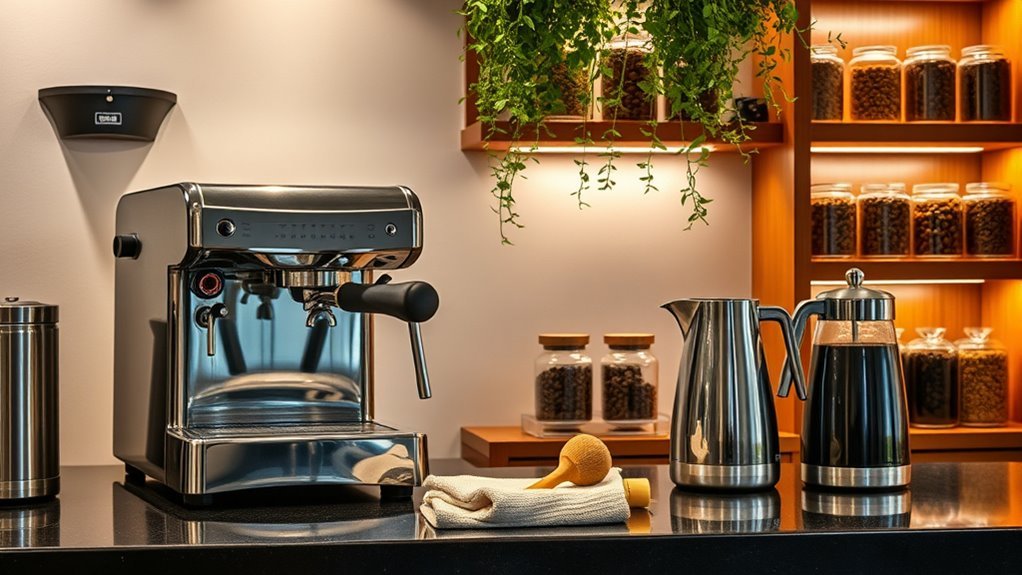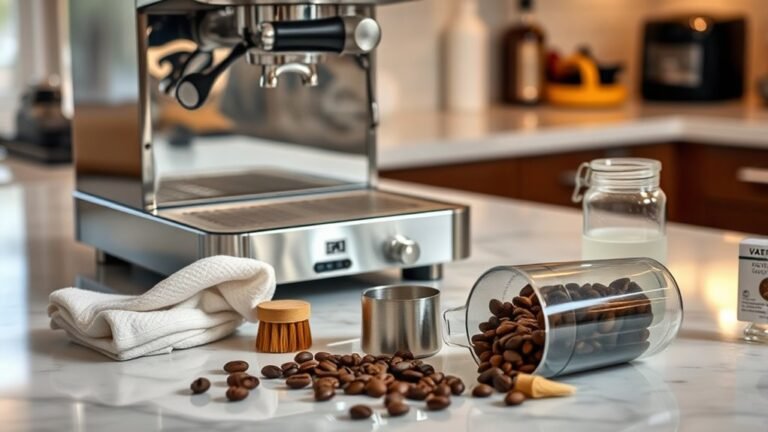How to Clean and Maintain Your Coffee Equipment
To keep your coffee equipment brewing fresh, clean removable parts daily and descale machines regularly to prevent mineral buildup. Rinse components like drip baskets and French press filters after use, and flush espresso group heads while cleaning grinders weekly to avoid stale oils. Store gear in a dry, organized space, and use appropriate brushes or eco-friendly cleaners for best results. Following these steps guarantees flavor and longevity—explore further for detailed routines tailored to your specific coffee setup.
Understanding the Importance of Regular Cleaning

Although you might be enthusiastic to enjoy your coffee, regularly cleaning your equipment is vital to maintain both flavor quality and machine longevity. Neglecting cleaning frequency leads to buildup of oils, residues, and minerals that degrade taste and strain your machine. By committing to a consistent cleaning schedule, you guarantee your coffee tastes fresh and your equipment operates smoothly over time. This practice prevents clogging and mechanical wear, directly contributing to equipment longevity. You don’t need complex routines—simple, frequent cleanings tailored to your device type will suffice. Prioritizing this maintenance step grants you the freedom to savor each cup without compromise, optimizing your investment and daily ritual. Remember, disciplined cleaning isn’t a chore; it’s the key to enjoying coffee on your terms, every day.
Cleaning Your Drip Coffee Maker
You should start by rinsing removable parts daily to prevent buildup and maintain flavor. Don’t forget to descale your machine regularly to remove mineral deposits that affect performance. Also, keep your filters clean and replace them as needed to guarantee peak brewing.
Daily Cleaning Steps
Since coffee oils and residue build up quickly, daily cleaning of your drip coffee maker is essential to maintain flavor and machine performance. Start by removing the filter basket and rinsing it thoroughly to eliminate any coffee residue. Wash the carafe and lid with warm, soapy water, ensuring no grounds remain. Wipe down the machine’s exterior and warming plate with a damp cloth to prevent buildup. Establishing a consistent cleaning schedule helps you avoid stale flavors and extends your equipment’s lifespan. Remember, a quick daily rinse after brewing is more effective than letting residue harden. By integrating these simple steps into your routine, you’ll enjoy fresh coffee every morning without the hassle of deep cleaning more often than necessary. Freedom in your coffee ritual starts with proper daily maintenance.
Descaling Importance
When mineral deposits build up inside your drip coffee maker, they can disrupt water flow and affect brewing temperature, leading to weaker coffee flavor and potential machine damage. Regular descaling is essential to keep your machine running smoothly and your coffee tasting great.
Consider these points for effective maintenance:
- Follow recommended descaling frequency based on water hardness and usage.
- Use safe descaling methods like citric acid or commercial descalers.
- Run a clean water cycle after descaling to rinse residues.
- Avoid skipping descaling to prevent costly repairs.
- Monitor brewing time and taste as indicators of scale buildup.
Filter Maintenance Tips
A clean filter is essential for maintaining your drip coffee maker’s performance and ensuring the best flavor extraction. Start by identifying which filter type your machine uses—paper, metal, or reusable mesh. Paper filters are single-use, so replace them with each brew to avoid stale flavors and clogging. Metal and mesh filters require regular rinsing immediately after use to remove coffee oils and grounds, preventing buildup that can affect taste. For deeper cleaning, soak reusable filters in a mixture of warm water and vinegar once a week, then rinse thoroughly. Monitor your filter’s condition closely; worn or damaged filters reduce efficiency and can compromise flavor. By keeping your filters clean and replacing disposable ones consistently, you’ll enjoy a smoother, richer cup every time, giving you the freedom to savor your coffee without hassle.
Maintaining Your French Press
Although the French press offers rich, full-bodied coffee, it requires regular maintenance to guarantee peak performance and taste. To keep your French press in top shape and enjoy flawless brewing techniques, follow these practical steps:
Maintaining your French press regularly ensures rich flavor and flawless brewing every time.
- Disassemble and rinse all parts after each use to prevent residue buildup.
- Use warm water and mild soap; avoid harsh detergents that can affect flavor.
- Clean the mesh filter thoroughly to remove trapped coffee oils and grounds.
- Periodically soak components in a vinegar solution to dissolve mineral deposits.
- Dry all parts completely before reassembling to prevent mold or rust.
Caring for Espresso Machines

You should start by following a daily cleaning routine to prevent buildup and guarantee consistent flavor. Regular descaling is essential to remove mineral deposits that can affect your machine’s performance. Don’t forget routine maintenance, like checking seals and cleaning group heads, to keep your espresso machine running smoothly.
Daily Cleaning Routine
Since espresso machines are used daily, establishing a consistent cleaning routine is crucial to maintain performance and flavor quality. Your daily coffee habits directly impact the equipment longevity and the taste of each shot. By dedicating a few minutes each day, you guarantee your machine stays in top shape and delivers freedom from bitter, stale flavors.
Here’s a simple daily cleaning checklist for your espresso machine:
- Flush the group head with hot water after each use to remove coffee grounds.
- Clean and wipe down the steam wand immediately after frothing milk.
- Empty and rinse the drip tray and portafilter basket.
- Backflush with a blind filter if your machine supports it.
- Wipe the machine’s exterior to prevent buildup and stains.
Stick to this routine, and you’ll enjoy consistent espresso without compromise.
Descaling Process Importance
When mineral deposits build up inside your espresso machine, they can hinder performance and affect the taste of your coffee. To keep your machine running smoothly and guarantee every cup tastes right, you need to follow a proper descaling process. Pay attention to the descaling frequency recommended by your manufacturer, as it varies depending on water hardness and usage. Using the right descaling solutions is essential—they effectively dissolve mineral buildup without damaging internal components. Skipping or delaying descaling can lead to clogs, longer brewing times, and uneven heating. By committing to regular descaling, you not only extend your machine’s lifespan but also maintain the freedom to enjoy consistent, high-quality espresso anytime. Prioritize this step to safeguard your investment and your coffee’s flavor.
Regular Maintenance Tips
Although descaling is crucial, maintaining your espresso machine regularly guarantees it operates at peak performance between deep cleans. Sticking to a consistent cleaning schedule helps prevent buildup and prolongs your machine’s lifespan. By following a maintenance checklist, you confirm no essential task is overlooked.
Include these key steps in your routine:
- Wipe down the group head and steam wand after each use
- Backflush the machine weekly with a detergent designed for espresso machines
- Clean and replace water filters monthly
- Empty and clean the drip tray daily
- Inspect and lubricate moving parts quarterly
This practical approach to care gives you the freedom to enjoy flawless espresso without unexpected breakdowns. Regular, precise maintenance keeps your machine reliable and your coffee tasting its best.
How to Clean Coffee Grinders
Cleaning your coffee grinder at least once a week guarantees peak performance and flavor consistency. Depending on your grinder type—blade or burr—the cleaning process varies slightly. Blade grinders benefit from quick brushings and wiping, while burr grinders require more attention to disassemble and remove residual grounds. Regular cleaning frequency prevents stale oils and coffee buildup that can alter taste and damage components. Start by unplugging the grinder, then remove the hopper and burrs if possible. Use a small brush or cloth to clear out grounds, avoiding water on electrical parts. For stubborn residue, a dry rice grind can help absorb oils. Staying on top of this routine guarantees your freedom to enjoy fresh, untainted coffee every time without hassle or flavor compromise.
Removing Mineral Deposits and Scale
Why does mineral buildup form inside your coffee equipment, and how can you effectively remove it? Mineral buildup occurs when hard water leaves deposits inside your machine, impairing performance and flavor. To keep your coffee gear running smoothly, use descaling solutions designed to dissolve scale without damaging components.
Here’s how to tackle mineral buildup:
- Choose a descaling solution compatible with your equipment.
- Follow manufacturer instructions strictly for dilution and timing.
- Run the solution through the machine as if brewing coffee.
- Rinse thoroughly with clean water to remove residues.
- Repeat descaling every 1-3 months, depending on water hardness.
Proper Storage of Coffee Equipment

After removing mineral deposits to keep your coffee equipment in top condition, storing it properly will help maintain its performance and longevity. Focus on coffee storage that shields your gear from moisture, dust, and extreme temperatures. Keep equipment in a dry, cool place away from direct sunlight to prevent material degradation and preserve functionality. Use airtight containers or protective covers for smaller parts and accessories. For better equipment organization, designate specific spots or shelves where each item fits securely, reducing clutter and minimizing the risk of damage. Proper storage doesn’t just protect your tools—it also streamlines your coffee routine, giving you the freedom to enjoy each brew without hassle. By maintaining a clean, organized space, you guarantee your coffee equipment stays ready for peak performance every time.
Tips for Handling Coffee Oils and Residues
Because coffee oils can quickly build up and affect both taste and machine performance, it’s important to address them regularly. Ignoring residue buildup leads to bitter flavors and clogs your equipment. To keep your coffee gear running smoothly, follow these tips:
Regularly cleaning coffee oils prevents bitterness and keeps your machine performing at its best.
- Clean brewing parts after each use to prevent oil accumulation.
- Use warm water to dissolve fresh coffee oil residues effectively.
- Disassemble removable components for thorough cleaning.
- Wipe down grinder burrs to avoid residue buildup that impairs grinding.
- Allow equipment to dry completely before reassembling to prevent mold.
Recommended Cleaning Products and Tools
Several key cleaning products and tools can make maintaining your coffee equipment much easier and more effective. Start with eco friendly cleaners designed specifically for coffee gear; they break down oils and residues without harsh chemicals, keeping your setup safe and sustainable. Essential tools include a soft-bristled brush for grinders, a microfiber cloth for wiping surfaces, and specialized cleaning tablets or powders for espresso machines. A small, flexible nylon brush helps clean group heads and portafilters precisely. Don’t forget a descaling solution that’s compatible with your machine to prevent mineral buildup. Using these products and tools regularly guarantees consistent performance and extends your equipment’s life. Choosing eco friendly options gives you freedom to maintain your coffee ritual responsibly and efficiently.
Frequently Asked Questions
How Often Should I Replace Coffee Machine Water Filters?
Imagine your coffee machine’s filter as a guardian of pure water, tirelessly working to keep your brew crisp. To keep water quality at its peak, you should schedule a filter replacement every two to three months, depending on your water hardness and usage. This timely swap guarantees your coffee tastes fresh and your machine stays healthy, giving you the freedom to enjoy every cup without worry or compromise.
Can I Use Vinegar in My Espresso Machine?
Yes, you can use vinegar for espresso machine maintenance, but cautiously. Vinegar cleaning benefits include removing mineral buildup and disinfecting internal parts. However, its acidity might damage rubber seals or leave a lingering taste if not rinsed thoroughly. To keep your freedom intact, dilute vinegar with water and run several clean water cycles afterward. This practical approach guarantees your machine stays clean without compromising performance or flavor.
What’S the Best Way to Clean Reusable Coffee Pods?
Cleaning reusable coffee pods is like giving your gear a fresh start every time. Start by rinsing them immediately after use to prevent residue buildup. Use a small brush or toothpick for stubborn grounds. For deeper cleaning, soak pods in warm, soapy water, then rinse thoroughly. Regular maintenance tips include drying completely before reuse to avoid mold. These cleaning techniques keep your pods fresh and your coffee tasting free and bold.
How Do I Prevent Mold in My Coffee Grinder?
To prevent mold in your coffee grinder, always guarantee it’s completely dry before storing—moisture is mold’s best friend. Use grinder storage in a cool, dry place with good humidity control to keep moisture levels low. Avoid leaving leftover grounds inside, and clean regularly to remove oils and residues. This way, you maintain freshness and freedom from mold, so your coffee tastes great every time without hassle.
Is It Safe to Clean Coffee Equipment in a Dishwasher?
You can’t assume dishwasher safety for all coffee equipment parts, so you’ll want to check the manufacturer’s guidelines first. Some components, especially those with delicate seals or electronics, won’t hold up well in a dishwasher. Instead, use gentle cleaning materials like mild soap and a soft cloth or brush. This approach keeps your equipment in top shape without risking damage, giving you the freedom to enjoy great coffee without hassle.






